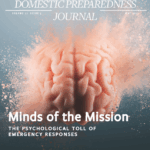The valuable lessons that COVID-19 taught community leaders about their emergency preparedness plans were often painful and expensive. However, not learning from those lessons would disrespect the virus’s 6.9 million victims worldwide. There are no good excuses for these failures. While it is true that COVID-19 was a “novel” virus, that only mattered to virologists as they developed a vaccine. To everyone else, it was a virus – like the influenza virus – and plenty of warning and money was allegedly spent preparing for pandemic influenza. These plans’ failures had little to do with the genomic sequence of the virus itself and more about what these plans were not:
- Familiar,
- Equitable and inclusive,
- Interconnected and scalable,
- Clear and actionable, and
- Resilient
Familiarity
An internal unpublished after-action report that Crisis Prevention & Response Inc. conducted in 2022-2023 for a large midwestern state found that four of the five public health leaders who signed the most recent version of the state’s pandemic plan in 2016 had left the agency by February 2020. As such, it is possible that the new senior public health leadership did not use that document during COVID-19 because they did not know it existed.
Signatures on plans are not formalities but rather the only way to know that leadership “owns” them. In the after-action report, since the leaders’ successors did not sign the plan, there was no evidence that they were familiar with or aware of it, much less invested in it.
Making plans familiar to all stakeholders (senior leadership and the rank and file) subsequently includes training and exercising. Four key elements of a solid plan include:
- Organizing – Who (by position) will execute each plan element? Each element should be staffed three deep because the agency cannot count on everyone being in place when the crisis occurs or staying in that position until the situation ends.
- Equipping – What space, stuff, and systems are required to execute the plan? If all these elements are not normally in place (see the section on scalability below), where will the excess come from, and how will it be paid for? Within systems, what essential information elements are necessary to manage the problem? Where do those elements come from, and how do they get where they need to go?
- Training – Does everyone mentioned in the plan know how to execute the elements assigned to them? Training includes:
- Familiarization with the organization,
- Familiarization with the plan,
- Technical training on relevant parts of the plan,
- General emergency training, and
- Leadership training for team leaders.
- Consider using a Position Task Book to document each person’s progress toward excellence.
- Exercising – Are elements of the plan exercised frequently enough so that (a) people are comfortable with their roles and responsibilities, and (b) flaws are identified and resolved? Tabletop exercises can help find the plan’s flaws, drills can test its execution, and full-scale exercises can determine how well they work in the larger picture of response activities.
Equitability and Inclusiveness
Frequently, a handful of well-intentioned emergency managers write plans with little influence from the people they intend to protect. As a result, planning documents are not actionable for many community members. “Nothing about us, without us!” plead advocates for vulnerable populations, including those with access and functional needs. More than translating documents into Spanish (though that is a good start), equity starts with understanding the people disasters may impact and recognizing these stakeholders’ strengths and vulnerabilities. Inclusivity means including representatives from these populations in the development and testing phases.
Interconnectedness and Scalability
Planners often write each document from that agency’s perspective on a single concern. One example of a siloed process is separate plans for COVID-19 testing and contact tracing. Contact tracing begins with a positive test result, but health agencies did not immediately connect these two systems. Without this connection, test results came back from disparate laboratories – each in their own format and through different channels, including fax and postal mail – and the data could not readily flow into a contact tracing program. The errors and delays that manual data handling caused gave time for the disease to spread before some patients could be contacted with their results.
Another example of siloed data processing is damage assessment information after a storm. For example, the local building department inspects the property to determine the building’s safety for occupancy and files a damage report. A paper copy is then available to the property owner and other city agencies, each needing to track that property and manage information before the homeowner can obtain a permit to start repairs.
When exercising plans, it is imperative to know where each essential element of information comes from and how it gets safely to where it needs to go. Planners should ask how information is shared between agencies and with the public. If an agency cannot process data at scale, those within the agency cannot properly serve their constituents in an emergency.
Clarity and Actionability
Using passive voice may indicate that crucial information is missing. For example, “Employees will be notified” fails to identify who will notify employees and how. Exercises can dig deep into these vague statements and indicate how to make documents more precise for the agencies who own these plans. Without good communication and clarity in communication elements, agencies cannot fully execute their plans. Questions to answer include:
- Who (by position) sends messages (and who fills in if the primary person is unavailable)?
- Are those messages pre-scripted, or must they be written and approved ad hoc (and, if so, what is that process)?
- Are the messages effective and accessible to all?
- What is the primary channel of communication for each message to each audience?
- How does the agency know and record that it received messages?
- What is the secondary communication channel in case the first is unavailable or fails to produce a response from all recipients?
- Do employees and other stakeholders know how to respond to these messages?
Reviewing the plan elements needed in a discussion-based exercise at this level of detail would add clarity and actionability to the document.
Resiliency
Each plan, written in a vacuum, assumes that the rest of the world will continue to operate under normal conditions when a particular crisis occurs. A significant lesson learned in the past few years is that crises are not independent isolated events. For example, major civil rights events occurred during COVID-19, as did some hurricanes. As such, mass gathering and sheltering plans that did not account for the pandemic were fraught with danger. In addition, all planning documents must work during a prolonged power outage because multiple other problems could result from the same storm or nefarious act that caused the power outage. During the testing phase, consider how this plan might support other emergency plans during simultaneous catastrophes, each with cascading effects.
Improving Emergency Plans
There are many ways to improve the emergency planning process, including the following:
- Build plans to deliver essential services to constituents despite the risks rather than building them around the risks themselves.
- Include every constituent with a stake in the process, especially vulnerable and marginalized communities.
- Incorporate clarity and resilience in each document. Agencies will execute many plans on bad days with little practice and oversight. Make success possible, if not easy. Ensure multiple plans work seamlessly together within the organization and between stakeholder organizations.
- Test plans to ensure they work as intended. Keep testing because essential parts – like the people who execute them, the systems, and the locations – may change frequently.
Continuous improvement, not perfection, is the goal. If each activation of a plan, and each exercise of that plan, is carefully evaluated and documented, then the after-action report and improvement plan will contain a list of corrective actions to improve the plan, including: the organization of the plan (who does what); the equipment, facilities, and systems needed to execute the plan; the training of personnel to execute the plan; and future exercises of that plan. All plans should have a regular review schedule so organizations can ensure their policies and procedures stay current.

Rick Christ
Rick Christ advises emergency management agencies and healthcare preparedness organizations worldwide on training and exercises. He has been designated a Master Exercise Practitioner and a Professional Continuity Practitioner by the U.S. Federal Emergency Management Agency. He designs, delivers, and evaluates exercises for state and local governments. He is a Lean Six Sigma Green Belt and an apostle for continuous improvement. Christ is a senior consultant with Crisis Prevention and Response, Inc.
- Rick Christhttps://domprep.com/author/rick-christ






